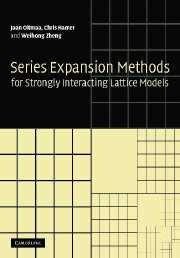Book contents
- Frontmatter
- Contents
- Preface
- 1 Introduction
- 2 High- and low-temperature expansions for the Ising model
- 3 Models with continuous symmetry and the free graph expansion
- 4 Quantum spin models at T = 0
- 5 Quantum antiferromagnets at T = 0
- 6 Correlators, dynamical structure factors and multi-particle excitations
- 7 Quantum spin models at finite temperature
- 8 Electronic models
- 9 Review of lattice gauge theory
- 10 Series expansions for lattice gauge models
- 11 Additional topics
- Appendix 1 Some graph theory ideas
- Appendix 2 The ‘pegs in holes’ algorithm
- Appendix 3 Free graph expansion technicalities
- Appendix 4 Matrix perturbation theory
- Appendix 5 Matrix block diagonalization
- Appendix 6 The moment–cumulant expansion
- Appendix 7 Integral equation approach to the two-particle Schrödinger equation
- Appendix 8 Correspondences between field theory and statistical mechanics
- Appendix 9 Computer programs
- Bibliography
- Index
8 - Electronic models
Published online by Cambridge University Press: 06 January 2010
- Frontmatter
- Contents
- Preface
- 1 Introduction
- 2 High- and low-temperature expansions for the Ising model
- 3 Models with continuous symmetry and the free graph expansion
- 4 Quantum spin models at T = 0
- 5 Quantum antiferromagnets at T = 0
- 6 Correlators, dynamical structure factors and multi-particle excitations
- 7 Quantum spin models at finite temperature
- 8 Electronic models
- 9 Review of lattice gauge theory
- 10 Series expansions for lattice gauge models
- 11 Additional topics
- Appendix 1 Some graph theory ideas
- Appendix 2 The ‘pegs in holes’ algorithm
- Appendix 3 Free graph expansion technicalities
- Appendix 4 Matrix perturbation theory
- Appendix 5 Matrix block diagonalization
- Appendix 6 The moment–cumulant expansion
- Appendix 7 Integral equation approach to the two-particle Schrödinger equation
- Appendix 8 Correspondences between field theory and statistical mechanics
- Appendix 9 Computer programs
- Bibliography
- Index
Summary
Introduction
In the preceding chapters we have developed a number of series expansion methods, and shown how to use these to study lattice spin models of various kinds. While this encompasses a great deal of interesting physics it does not include perhaps the richest, most interesting, and most challenging area of all: strongly correlated electron systems. Of particular interest here are the cuprate high Tc superconductors and the manganite ‘colossal magnetoresistance’ (CMR) materials. These systems are far from fully understood but it seems clear that a complex and subtle interplay between charge, spin, and perhaps other degrees of freedom plays a vital role.
A number of generic lattice models for strongly correlated electron systems exist. Besides the Hubbard model, which was briefly introduced in Chapter 1, there is its derivative the ‘t–J model’, the Anderson model, the Kondo lattice model, the Falicov–Kimball model, and others. These all present difficult problems, with little in the way of exact or rigorous results. Many approximate approaches, both analytical and numerical, have been used. In this chapter we will discuss the application of series methods, both at T = 0 and at finite temperatures, to some of these models. Some successes have been achieved but, generally speaking, the series are shorter and the analysis more problematic than for spin models. A particular difficulty, for ground-state calculations, is that series are not well suited to studying continuously variable electron density, although we will illustrate one attempt to overcome this.
- Type
- Chapter
- Information
- Series Expansion Methods for Strongly Interacting Lattice Models , pp. 179 - 210Publisher: Cambridge University PressPrint publication year: 2006

